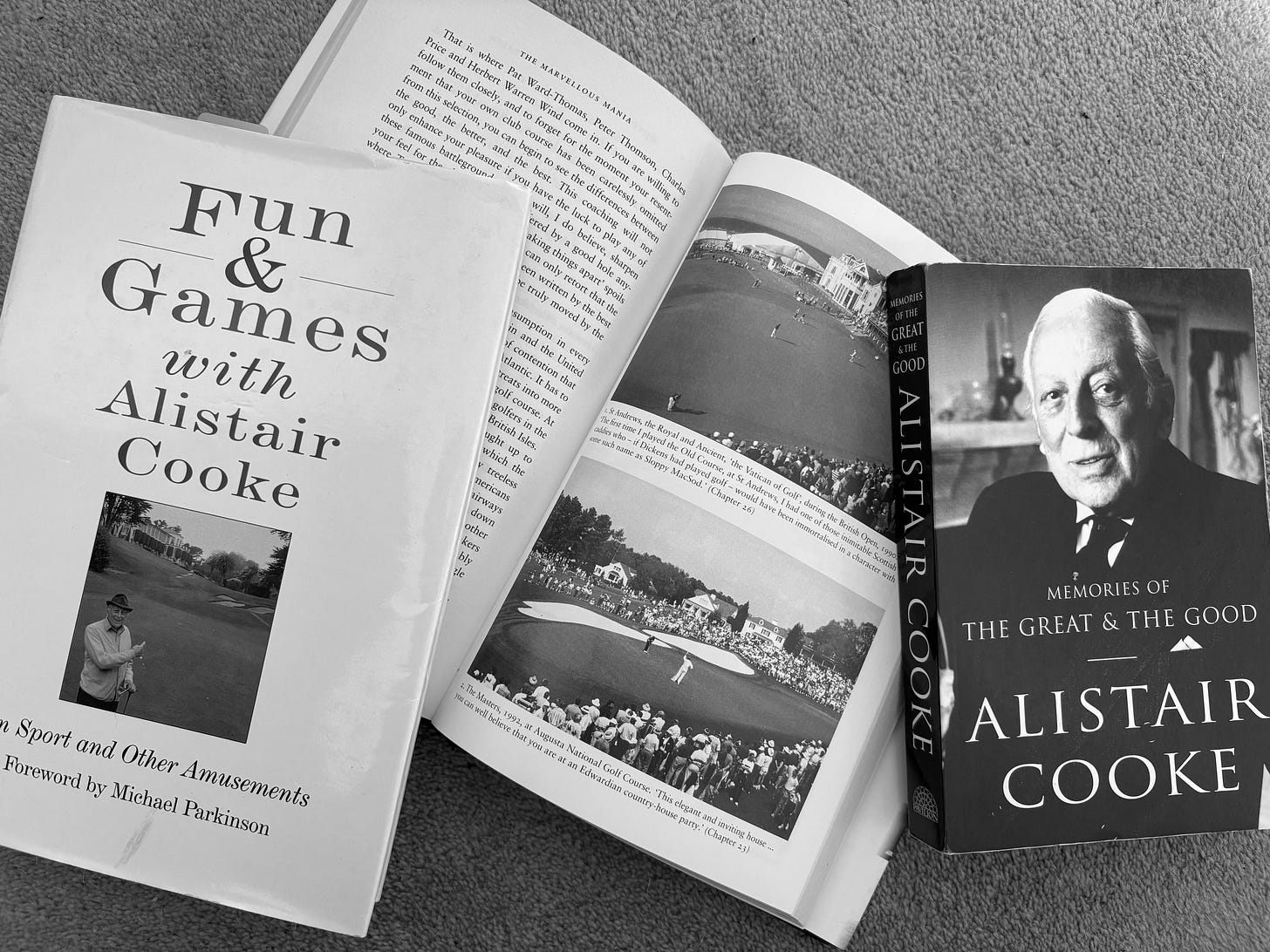Amidst the fading memories of an eighties childhood, the sound of Alistair Cooke’s voice, delivering his weekly sermon from across the pond, left an indelible mark. Sundays in our kitchen would stand still to let his deliberate pace re-set us for the week ahead, and at least once a year – usually the week after the action – his sharp attention would turn to what he called “the same ravishing landscape” of Augusta National Golf Club.
For more than thirty years, Cooke would attend The Masters tournament, in the process becoming close enough to Robert Tyre Jones Jr, whose cabin he and Pat Ward-Thomas would frequent, to know that he hated to be called “Bobby”.
“Letter from America” would be delivered into a huge microphone, Cooke reading from a typed leaf of A4, but in these days of computerised everything, one blessing is that, alongside many of the original, yellowing crib-sheets, sits an archive of audio files; his legacy preserved as intact as that of his great friend, golf’s finest amateur.
It is only just April, but another unforgettable feature of growing up in a world without internet was the anticipation of Masters week, and of that Sunday evening broadcast, and so I delve back into Cooke’s writing on golf, and seek out a few editions to accompany me as all thoughts drift towards what he called “a slowly beckoning beauty” in Georgia.
In one edition, Cooke delves into the history of the property, and I am struck by how random the path is, from “sumptuous botanical garden” via a failed hotel development to this annual carnival of golf. At every turn, terrible luck seems to play its cards on first the Berckmans, whose fruit farm fell into decay after the old man passed away, and then Commodore Stoltz, whose dreams of a real-estate empire disappeared in the face of a hurricane one morning in the roaring twenties.
And then some “Wizard of Wall Street”, Clifford Roberts, and Bob Jones, thrown together by fate in the dining room of an Augusta hotel, found themselves peering at a view the rest of the golfing world may never never tire of.
For in Cooke’s words, “he looked beyond what is now the long cathedral sweep of the tenth fairway, and shifted his gaze across to Rae’s Creek, the little bridge and the shining water. ‘This’, said Jones, ‘is the place’. And so it was. And so it is.”
And through every back nine of this little Invitational, as Jones originally called it, the same themes of luck – good and bad – and of the building of memories and stories drift back across the Atlantic, holding back the march of modern life for just a few hours in favour of the telecast.
Cooke called Augusta a “sanctuary from the real world”, and noted how the concerns of the political landscape upon which his weekly reflections usually focused seemed to recede under “the towering Georgia pines”; between the Azaleas and the Dogwoods, “and the Magnolias and the Firethorn”.
Elsewhere, describing the concentration of the competitor as they creep through Amen Corner, trying to ride Lady Luck back up the hill to that magnificent clubhouse, he talks of “a trance in which all of life before and after is blotted out”, and every April we golfers seem to fall under the same spell, enthralled by the beauty of this distant place, and of the gladiatorial march of the greats, as they produce occasional glimpses of a transcendent mastery.
The course that Jones built, in collaboration with the great Alister Mackenzie, has changed in a thousand ways since this “American Festival” first caught the imagination of the golfing public; yet the strategic brilliance of the puzzle those two gentlemen left behind continues to charm, continues to test and perplex even the modern athlete.
Decisions must be made on each and every hole, and the beauty of this major being played on the same rolling carpet every year is that there is nowhere to hide from the stories of the past. No one can pull on a Green Jacket – surely the finest sartorial moment of any golfing career – without carrying those same tranquil waters as their forebears, and The Masters seems to channel the world’s best to the top of those vast white leaderboards like no other competition, not even The Open.
Jones spoke of the desire to “give pleasure to the greatest possible number of players… (that Augusta should) never become hopeless for the duffer, nor fail to concern and interest the expert.” And alongside those eighteen blessed holes, carved through an old fruit farm, Jones also leaves a further legacy that seems even more valuable in the modern age – an insistence on courtesy, and decency. As the players line up their putts, Cooke notes a deafening “silence around every green”, and suggests that one might question whether they were at the right place for the golf after all, and not “at some vast open-air prayer meeting”.
The Masters is, in every way, an “occasion civilised more than the ordinary by the still haunting presence of its founder”, as Cooke put it, and if ever there was a journalist perfectly formed to report on this annual retreat into the kaleidoscopic celebration of golf that is The Masters, it was Alistair Cooke.
What a legacy those two left us.
Not long to go now…
This edition of pitchmarks first appeared on Golf Today’s website, along with a number of other articles. You can find mine here, along with several other excellent contributors under the Opinion tab.






Wonderful!
There are times when brevity conveys the greatest compliment, si in a word—/
“Brilliant.”